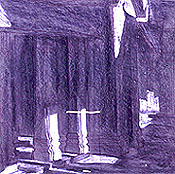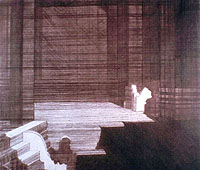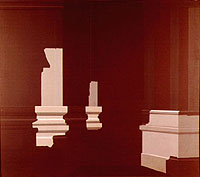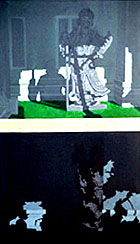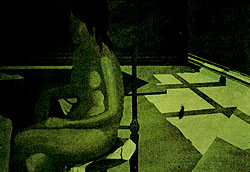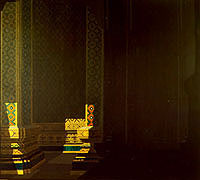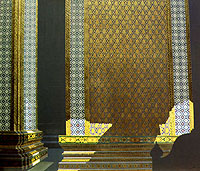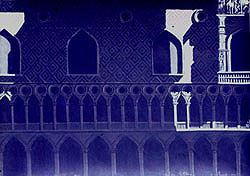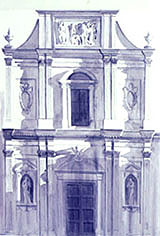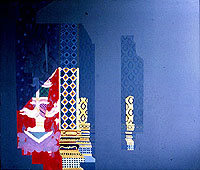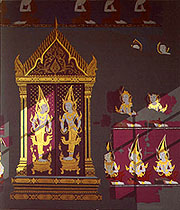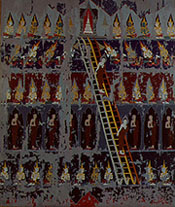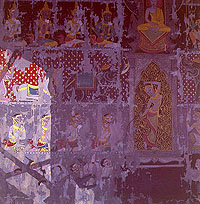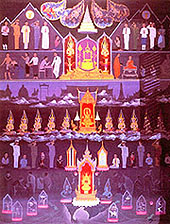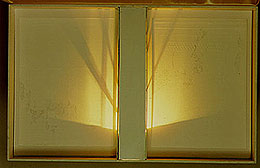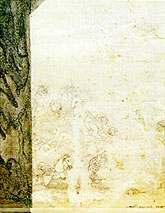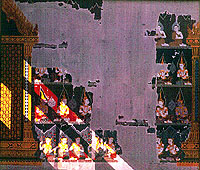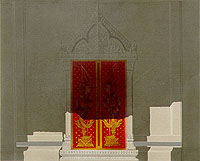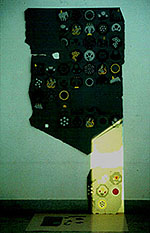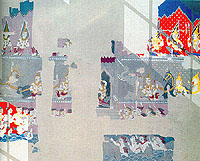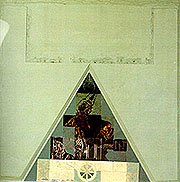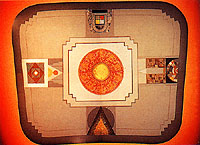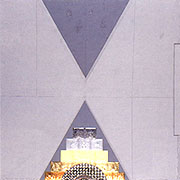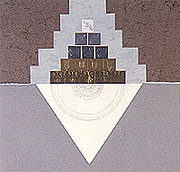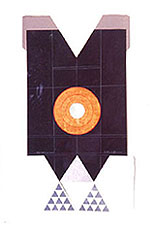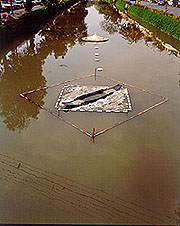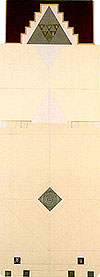 |
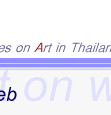 |
 |
|||||||||||
 |
 |
 |
 |
 |
|||||||||
 |
|||||||||||||
CREATIVE IDEA OF HIS ART WORK
In the early period of his work, Preecha Thaothong was first known for his use of natural light and shadow in paintings, especially in Thai culture. He believed that this was a way of expressing the uniquely tranquil Thai character. All these works depended on light and shadow or golden color. Later, Preecha began to use glittering surfaces to convey an idea of being Thai. These works combined traditional Thai techniques with Western modes of painting, creating the artists’ own unique style.
Preecha’s works merged forms, idea and techniques to reflect the essence of Buddhist philosophy in order to lead the society step by step. His works emphasized Thai character: faith, tranquillity and the role of Buddhism on contemporary life.
His conceptual frame of work could be divided into 17 series :Series 1: 1969 - 1972
The works were inspired by the desire to know about the visual composition of nature. These works were to study on tone, color, light, shadow and space. The shapes and forms were created from the artist’s visual experience of nature.
Series 2 : 1972-1974
Light and shadow were developed to create shapes and space. There were three main factors employed to determine direction, position and shapes of light and shadow. These factors were the source of light, objects reflecting the light, and the screens. As a result, the works effectively expressed the tranquillity, which the artist intended.
Series 3 : 1974-1975
A study of the rules and reasons of setting shape of light and shadow in order to develop and relate designed color and tone together in the area of form of light and shadow in unity. It brought content, subject and design of Thai art and culture combined with the form of light and shadow more harmoniously. Therefore, the result of the content-subject was reflected in the forms of the contemporary work of art.
Series 4 : 1975-1976
Changing related scales developed the variations of the shapes of light and the shadow areas. The scale of light was kept smaller than shadow. The area exposed to the light was painted in brighter tones, the darker tones were put in the shadow . This unified the features in the shapes of light and shadow and gives a more substantial meaning of tranquillity and concentration, which was the essential concept of modern Thai art.
Series 5 : 1976-1977
These works were results of the study of the architecture of churches and buildings in
Europe, especially in Italy. The limits of space and the tremendously tall buildings gave a very straightforward expression. The shapes of light and shadow were expressed directly in the structure. As the result, paintings were direct and gave a sense of tranquillity and concentration in the form of modern art.
Series 6 : 1977-1979
Following the study on architecture in Italy was a study on the architecture of temples in Thailand. The influence of previous works was still felt and the effect of the paintings was to give direct but multi-dimensional view. The shapes and composition indicated stability and calm. The essence of tranquillity and concentration were central in Thai modern art.
Series 7 : 1979-1981
The works shifted from an outside to an inside view of Thai architecture. The accent of light, breaking through the structure of the buildings, threw some shadows on the Thai traditional mural paintings telling the story of the Buddha’s life. Cracks on the wall made different shapes and textures. Light determined the shapes and colors of the picture. Shadow indicated the more severe tones. As a whole, the works expressed tranquillity and holiness implied in the story of Buddha’s life, united by light and shadow.
Series 8 : 1981-1982
The techniques and ideas were developed from the preceding series, based mainly on the expressions of light, shadow and form found in Buddhism art. The point was the experiment in the use of mixed media: light from slides, multi-vision, still life, or movies, putting the light on the mural paintings. This mixed media conveyed tranquillity of Thai contemporary art.
Series 9 : 1982-1983
The creation of shapes and symbols in mural paintings on the celebration of Bangkok’s Bicentennial Year originated the artist to create combinations of shapes and symbols of light and shadow which was an image of contemporary Thai painting.
Series 10 : 1983-1984
The works were experimented in various techniques: drawing, printmaking, mixed media and painting, mixed with electric lights, to present new expressions of mixed media and mixed techniques, by using shapes and symbols in Thai culture and traditional Buddhist art.
Series 11 : 1984-1986
These works reviewed shapes and symbols in stories of the incarnations (Jataka) and Buddha’s biography. Shapes and elements as well as light and shadow were combinedd to express the meaning of the pictures. Natural light and surroundings were sub-elements, which enter the works
Series 12 : 1986-1987
In this series, the emphasis was on the shapes and stories of Buddha’s history, which was the main theme in the paintings. No expression of light and shadow were employed here.
Series 13 : 1987-1991
Buddha’s history were repeated here with a certain design. Light and shadow were reviewed simply, in geometric forms. The theme remained tranquillity and concentration
Series 14 : 1991-1993
The works brought more symbols from traditional Buddhist history into use as a mean of expression. The paintings were simpler and the symbols were repeated. Artificial light from slides, and other electric lighting was mixed with the simple geometric shapes and forms. Tranquillity and concentration remained the central themes of the work.
Series 15 : 1993-1994
Symbols were created from shapes found in Buddhist art. The shapes of elements composed in the paintings were symmetrical. The mixed technique that brought together collage, scraping and painting, was an experiment in shape and composition. Light and shadow was no longer used in making a salient point in the pictures then. The focus of this series was on the shapes of symbols, tone, color and texture traces.
Series 16 : 1994-1995
Symbols in simple orderly shapes were created symmetrically on shiny materials with different volumes and textures. The techniques were mixed between collage, drawing, scraping and painting in search of a harmony of texture, shapes, space and materials with both Thai and Western elements to create a complete effect of Thai symbols in contemporary art.
Series 17 : 1996-present
In this step, shapes, designs, and materials were united with the artist’s idea of Buddhist art. The idea of shapes and the traditional concepts , past and present, were compared. The subject revealed the artist’s realization of Thai community and wisdom from the past to the present. Expressions of forms, ideas, and techniques were used to indicate Buddhist philosophy, which tends to be built up.
Future Trend
Now Preecha is an assistant professor in Thai art at Silpakorn University. He still develops his creative idea of art continually. Using the traditional Thai technique together with the contemporary technique, he continues creating work that would be more self-contented than attaching to the form approved by the society. He works both in fine art and installation, which negotiated with outer environment. He dreams to build a temple with the structure of his own creative style, and the interior decorations with his mural paintings and lighting system. This is to convey his strong concept on rhythm and creative thinking.
